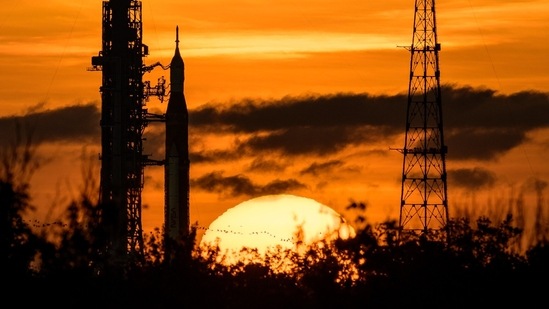Artemis 1 mission: NASA gives ‘go ahead’ to re-attempt launch today
The first attempt to launch NASA Artemis 1 mission was called off after the crew ‘ran off time’ in the two-hour launch window available on Monday.
After solving the problem of hazardous hydrogen leak, launch controllers have resumed flow of liquid hydrogen to the core stage after warming up a quick disconnect in the engine section where a hydrogen leak was detected, NASA has updated.

The National Aeronautics and Space Administration (NASA) had given a go ahead with second attempt to launch its uncrewed moon mission Artemis 1 in the two-hour launch window opening at 2:17 pm ET (11:47pm as per Indian time) on Saturday.
This second attempt is planned after the first was called off as the space launch system developed a technical snag. The latest update is that the loading of propellants into the Space Launch System rocket is underway after receiving official permission from Launch Director Charlie Blackwell-Thompson to proceed with the scheduled launch.
Earlier, the meteorologists at NASA had raise concern of scattered rain showers. They have predicted only 60 per cent favourable weather at the start of the launch window, however, it will subsequently improve to 80 per cent at the end.
NASA told that it will take the final call for the launch after inspecting the prevailing condition. “The mission management team will meet early in the morning (by noon as per Indian time), Saturday, Sept. 3 and give the final determination for a “go” or “no-go” decision to begin tanking operations,” NASA then said.
Why it didn't take-off on Monday ?
The first attempt to launch NASA Artemis 1 mission was called off after the crew ‘ran off time’ in the two-hour launch window available on Monday. The countdown was stopped at T-40 mins after the crew found a technical flaw in one of its engines.
NASA informed that a bleed test to get the RS-25 engines on the bottom of the core stage to the proper temperature range for lift-off was unsuccessful.
Before launch, the engine was to be conditioned i.e. to be bled with liquid hydrogen and oxygen.
This problem can be simply understood as that one of the four main engines could not be properly chilled ahead of its ignition.
Crew came with a troubleshooting plant but could not solve the problem. After the troubleshooting didn’t work, the launch director asked the hydrogen team to come up with a fresh strategy to address the problem.
When and where to watch
Netizens are asking how they can watch the livestreaming of the event. They can watch the launch with commentary directly from the following window. Livestream for the event has started at 3:15 pm with loading of propellant in the space launch system.
Alternatively, the launch is also live-streamed on NASA’s media platform- NASA television on the agency’s website and the NASA app, and its social media handles of Twitter, Facebook, LinkedIn.






